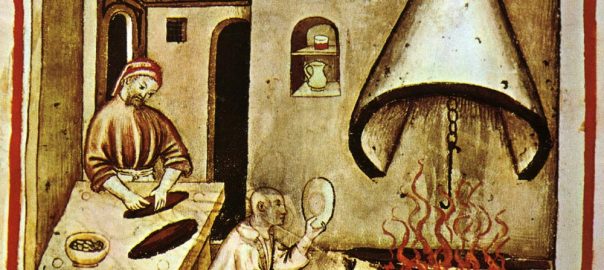Only one redaction challenge this time around—but one that appeals to all ages: medieval jello! Sampling on February 18. Even if you don’t take the plunge to make it, join us for a tasting!
I pulled this from “Ouverture de Cuisine” (France, 1604).
PS: There is no vodka in this recipe. Please keep it that way. The Dominion isn’t that kind of fraternity. ![]()
To make jelly.
Take a pot of white wine, & chafe it very hot, then put therein three quarters of a pound of sugar, one ounce of cinnamon, one ounce of nutmeg, & one ounce of coarsely ground ginger, & put it therein to temper the hot wine, & let it sit three or four hours, then pass the wine through a strainer, at the end to have the spices removed, then have a bag of white cloth like those used to strain hippocras, then cast into the wine three spoons of cow’s milk, & have a little handful of coarsely ground almonds without peels, put them into the bag, then pass the wine through the bag two or three times, until it becomes clear, & take two ounces of good husblat well washed, & put them to boil with a little wine & water, until well melted, then cast it into the wine, when it is passed, through the bag it will make the prize of the jelly: when the jelly is half cold cast it into plates, & let cool until it becomes firm. Note if it doesn’t become at all firm enough, adding more husblat will help, because it could be that the husblat isn’t as good as others.
A note on “husblat”. I could not find a direct translation of this word. Based on the recipe, it clearly must be the gelling agent; none of the other ingredients would do this.
I did find a word very close to it: “husblas”. Husblas is a gelatin made from tendons, skin and bones of pigs and cows. It is used for jelly and desserts to stiffen. It could also refer to isinglass: a kind of gelatin obtained from fish, especially sturgeon, and used in making jellies, glue, etc., and for clarifying ale.
–Meadbh
To give color to the jelly.
To make red jelly.
Take turnsole & boil it with a little of your jelly before straining it, & give to it the color you want.
To make yellow jelly.
Give it color with saffron before straining it.
To make gray jelly.
Take the green of a bladder to temper into the jelly until it is enough.
To make black jelly.
Take almond peels that have been burned black, & put them to temper into your clear jelly, when strained let temper three or four hours, then pass it through a sieve to have the almond peels out, if you want that the jelly is not black enough putting in more peels should help.
To make black jelly.
Take peach stones, & wash them, & burn them well black, & break them small, & put to temper into the white jelly, when it is a little hot, & put the peach stones to temper therein two or three hours: then pass your jelly through a sieve: if you want that it is not black enough, you can do the same with the almonds.
To make green jelly.
Take the water that which boiled with citron peels or oranges, & good sugar, & ginger, & put green of bladder therein that the water will be very green, & make jelly without wine, & strain it like the others. Note if you put wine therein it removes the color green, & will make it gray.
Another green.
Take blue jelly & yellow jelly, & mix them together, you will have parrot green.
Violet jelly.
Take Indigo or blue of India, & break it in pieces, & put it to temper into the wine that it will be blue, then make jelly like the others.


I’ve been doing some research on how to turn wine into jelly, especially the ratio between “pot of wine” and 3/4 lb. of sugar, as well as how much gelatin would be needed for what volumes.
These modern recipes might help as guidelines:
http://www.nytimes.com/2010/07/25/magazine/25food-t-000.html (2c. wine, 1/4c. sugar)
http://www.eatingwell.com/recipe/250567/sangria-jello/ (4 c. liquid, 1/3 c. sugar–note that 2 cups of the liquid is grape juice)
http://www.geniuskitchen.com/recipe/moms-christmas-wine-jello-86885 (12 c. liquid/4 c. sugar — worth noting that 4 cups of the liquid is a sweet wine)
I came across the following reference to jellies in “The Cookbook Library: Four centuries of the cooks, writers and recipes that made the modern cookbook” by Anne Willan, Mark Cherniavsky (Univ. of CA Press).
Regarding English cooking, and the King’s banquet:
“All the dishes were borne before the King by figures of elephants, panthers, tigers, and other animals, admirably designed; but the finest things… were the jellies made in the shape of castles, towers, churches and animals of every variety…”
— Francescso Cheriacati, Italian papal emissary in England, 1517.
A cautionary note about the jelly redaction. (A more experienced chef might chuckle…)
I brought my wine just to a boil, then added sugar as the recipe stated. I had an immediate, foamy boil-over as a result. Take care when adding your sugar!